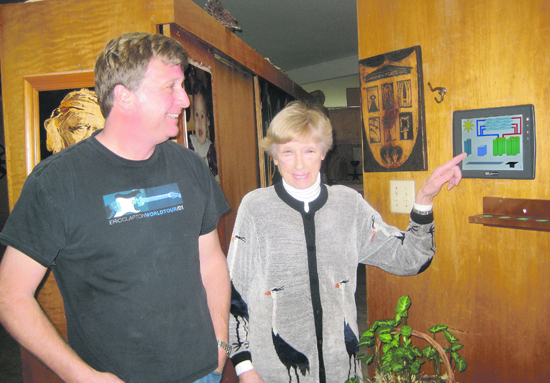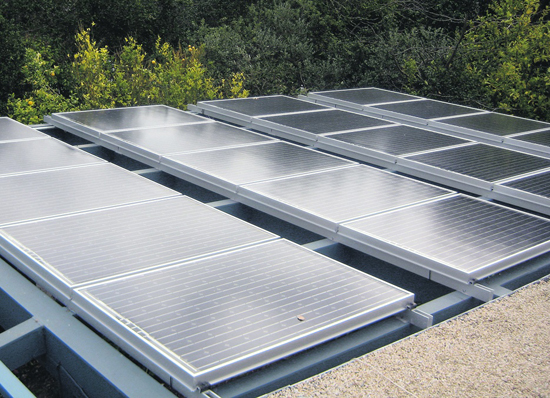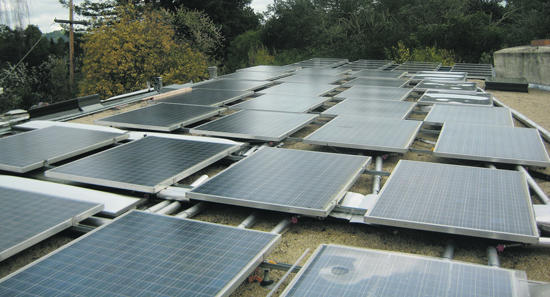 | | | Louise Clark (R) and son Charles Clark next to the control panel for their geothermal system Photo Sophie Braccini
| | | | | | Lafayette resident Louise Clark is not afraid to aim high. "I am getting more and more concerned about the climate and the environment," says Clark, "When I drive around the country and return to the Grinnell Glacier Trail in Glacier National Park, I see how over the years those ices have melted, and I want to do something about it." Clark decided that her home should become carbon neutral.
 Clark's property already had a solar array, and last year she decided to add a geothermal system that heats her home in winter and cools it in summer. Larger structures, like "The Barn" in Moraga that houses Canyon Construction, rely on such technology but it is not common to see it installed in a single-family home in Lamorinda, especially as a retrofit. But Louise Clark has an unique resource; her husband was the builder who conceived the family home 52 years ago, but it was her son Charles, an engineer, who designed the system now used on her Lafayette property.
Clark's property already had a solar array, and last year she decided to add a geothermal system that heats her home in winter and cools it in summer. Larger structures, like "The Barn" in Moraga that houses Canyon Construction, rely on such technology but it is not common to see it installed in a single-family home in Lamorinda, especially as a retrofit. But Louise Clark has an unique resource; her husband was the builder who conceived the family home 52 years ago, but it was her son Charles, an engineer, who designed the system now used on her Lafayette property.
 The system installed in her home uses the principle of geothermy. About six feet beneath the surface of the earth the temperature stays constant. Using a pump and pipes, water is sent down into the earth and either heats or cools, depending on the differential of temperature at each time of the year. This water is then circulated in the floor of the house to moderate its temperature.
The system installed in her home uses the principle of geothermy. About six feet beneath the surface of the earth the temperature stays constant. Using a pump and pipes, water is sent down into the earth and either heats or cools, depending on the differential of temperature at each time of the year. This water is then circulated in the floor of the house to moderate its temperature.
 The conversion was not too complicated at Clark's home because the original system used radiant heat - warm water circulating through the floor - but the water was heated by gas. Now the circulated water can absorb heat through two different sources: narrow wells that were dug close to the house (to a depth of 260 feet), or the solar energy that's collected on the roof.
The conversion was not too complicated at Clark's home because the original system used radiant heat - warm water circulating through the floor - but the water was heated by gas. Now the circulated water can absorb heat through two different sources: narrow wells that were dug close to the house (to a depth of 260 feet), or the solar energy that's collected on the roof.
 Charles Clark designed the computerized system that optimizes the use of the two sources of heating and cooling. "We have been through our first winter with this new system and my house stayed at the comfortable 72 degrees that I enjoy," says Clark, "now we are getting into the hotter part of the year and I expect the same performance."
Charles Clark designed the computerized system that optimizes the use of the two sources of heating and cooling. "We have been through our first winter with this new system and my house stayed at the comfortable 72 degrees that I enjoy," says Clark, "now we are getting into the hotter part of the year and I expect the same performance."
 The Clark family also owns property in Martinez, where Charles' ambition is to develop an apartment complex that will utilize the same design for heating and cooling. "My house is a kind of show case and experimentation ground," says Clark, who is an efficient activist, "I like to invite politicians here, too, and show them what can be done, so they can transmit the message to the government."
The Clark family also owns property in Martinez, where Charles' ambition is to develop an apartment complex that will utilize the same design for heating and cooling. "My house is a kind of show case and experimentation ground," says Clark, who is an efficient activist, "I like to invite politicians here, too, and show them what can be done, so they can transmit the message to the government."
 Charles Clark warns that the system may not be easy to install in every home, especially as an add-on. "This system is less expensive than gas to operate," says the engineer, "but the installation may be a bit pricey for a single family."
Charles Clark warns that the system may not be easy to install in every home, especially as an add-on. "This system is less expensive than gas to operate," says the engineer, "but the installation may be a bit pricey for a single family."
 The geothermal system is only the latest element of a grand scheme aimed at total sustainability. The solar panels that serve to heat water provide electricity as well and have been in place for about ten years. "My electricity bill has been about $5 for years," says Clark. The wood house has been covered in stucco, which provides an additional layer of insulation and all the windows are double-paned.
The geothermal system is only the latest element of a grand scheme aimed at total sustainability. The solar panels that serve to heat water provide electricity as well and have been in place for about ten years. "My electricity bill has been about $5 for years," says Clark. The wood house has been covered in stucco, which provides an additional layer of insulation and all the windows are double-paned.
 Louise Clark is not stopping here; she and Charles are working on even more improvements. "He (Charles) is in the process of putting new solar panels on 'trackers' that will follow the sun during the day. The trackers adapt, in real time, the angle of the solar panels to face the sun and maximize the energy output."
Louise Clark is not stopping here; she and Charles are working on even more improvements. "He (Charles) is in the process of putting new solar panels on 'trackers' that will follow the sun during the day. The trackers adapt, in real time, the angle of the solar panels to face the sun and maximize the energy output."
 Clark has completely eliminated the burning of fossil fuel in a house that was not conceived, half a century ago, with that objective in mind. She is proving that it can be done and hopes that many will follow in her footsteps. Clark is one of two recipients of Lafayette's 2009 Green Award in the "residents" category. A bit of a philosopher in action, Clarke cites Mahatma Gandhi: "Whatever you do will be insignificant, but it is very important that you do it."
Clark has completely eliminated the burning of fossil fuel in a house that was not conceived, half a century ago, with that objective in mind. She is proving that it can be done and hopes that many will follow in her footsteps. Clark is one of two recipients of Lafayette's 2009 Green Award in the "residents" category. A bit of a philosopher in action, Clarke cites Mahatma Gandhi: "Whatever you do will be insignificant, but it is very important that you do it."

|




